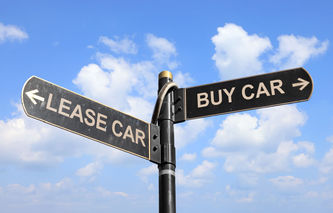If you're thinking about buying a car in the next 12 months, the information in this article can help optimize that process. With the average price of a new car hovering close to $30,000, it's important to make the right decision. There is a lot of money at stake, and it's a choice that can impact your life for several years.
The Car Buying Process
Arguably, the process of buying a car involves at least five distinct steps:
Determining How Much to Spend
Researching New Cars
Getting a Loan
Negotiating the Deal
Selling an Existing Car
Determining How Much to Spend
Buying a new car is a big expense, and the monthly payments can be a significant portion of a household's budget. If you're trying to figure out whether to lease or buy a car, or how much you can afford to spend, this website has several online calculators that can help. In fact, there is an entire section dedicated to automobile loan calculators, including:
Car Lease Calculator: allows the user to determine how much a car lease will cost each month.
Buy or Lease a Car Comparison Calculator: helps users to figure out if it's better to buy or lease a car.
Car Loan Comparison Calculator: allows the user to compare the overall cost and monthly payments of two or more loans.
Once you've determined how much you can spend on a car, it's time to decide on the features needed.
Researching New Cars
Buying a car is expensive, so it pays to do as much research as possible before visiting a dealership. A quick visit to an online resource such as Kelley Blue Book, a local library, or a bookstore, should yield a wealth of information on new cars. This phase of the investigation should focus on what is being offered in the marketplace, and how much each car will cost.
Test Drives
Avoid the temptation to start this research phase by going to dealerships and test driving cars. It's quite possible to fall in love with the wrong car. Start with a written list of what is needed in the vehicle. For example, the requirements should include the number of passengers the car should seat, cargo area, and how it's going to be used. Test drives will then be conducted on cars that fit those requirements. This process takes some of the fun out of new car shopping, but a car provides a service, and it's vital to make sure the car can deliver what is actually needed.
Safety Features and Ratings
In today's marketplace, automobile manufacturers compete not just on price but also on features. First and foremost, the car purchased should include as many safety features as possible. Stability control, anti-lock braking systems, traction control, daytime running lights, tire pressure sensors, and air bags are important to the owner's safety as well as passengers. Most automobile insurance companies will also offer their customers a discount on their premiums when certain safety features are present. That's good news because it means there is a financial benefit to buying features that go beyond that of personal safety.
Fuel Efficiency Technologies
In recent years, there has been a sharp increase in the different types of fuel efficient technologies used in cars. With the cost of gasoline on the rise, electric vehicles, hybrids, advanced transmissions, and fuel efficient engines will only add to the resale value of the automobile if the rise in gas prices continues.
Car Accessories
Finally, think about buying some of the premium features that make driving a car more enjoyable. Power windows, air conditioning, and automatic transmissions are all examples of car accessories that add to the car's perceived value as well as the owner's driving pleasure.
New Car Loans
When it comes to financing a new car purchase, this topic has been covered in-depth in our article: Car Loans. It's important to understand there are a lot of options when it comes to financing a new car. Local banks, car dealerships, and online companies are all competing for a customer's business, and a competitive car loan marketplace means lower costs for the consumer.
Negotiating with Dealers
Before negotiating with a dealership, it's important to narrow the choice of makes and models by doing some comparison shopping. There are a number of websites that provide users with a selling price for a car; oftentimes this is a very competitive price point. Once that information is clearly understood, then it's time to start negotiating.
The most important factors to consider when researching a car include:
- Affordability
- Reliability/ safety record
- Functionality (how it will be used)Moneyzine Editor
When talking to a salesperson, make it known that you've spent time researching cars, and know the make and model you'd like to purchase. If trading in a car, make sure to negotiate a price on the new car first. Try to make one deal at a time, and don't get the new car purchase mixed up with the trade-in. Let the dealership know that you've shopped for a car online too and that price becomes the one to beat. If the car dealership really wants the sale, they're going to negotiate, and will beat the online car price. If they don't, then go back home and order the car over the Internet. Don't let the dealership tell you it's impossible to get the car for the online price; people do all the time. That's what keeps those online car dealers in business.
Ordering a Car
When buying a car at a dealership, consider placing an order if they don't have the exact color and options wanted. Placing an order avoids purchasing an automobile with too many options. Finally, make sure you're happy with the color of the car. This sounds silly, but you are going to have to look at that car nearly every day for at least a couple of years. Ordering a car will take anywhere from 4 to 8 weeks longer than buying a car on the dealer's parking lot.
Insurance
Our article on automobile insurance provides a primer on the basics of insurance, and the types of coverage offered. If there is a loan on a car, then ownership of the vehicle is shared with another party. The lending institution will want to protect their investment, and that means the insurance policy will need to include collision and comprehensive coverage.
Trade-Ins
There are still several options in the marketplace when it comes to getting rid of a used car. Some of these require more legwork than others, but several are fairly straightforward. By far, the easiest way to sell an old car is to trade-in the vehicle when a new car is purchased. If possible, negotiate each deal separately. Don't allow the dealer to include the used car with the new car quote. This way, it's possible to completely understand how much is paid for the trade-in versus how much the new car will cost. Some dealers will try to bundle the two deals together in an attempt to hide the exact numbers used in their calculations; avoid getting into this situation.
Donating a Car
We've also talked about Donating a Car in the past, and this is something to give serious consideration. The Salvation Army has a specific program for this type of transaction, but read through the entire article we've published. For example, there are some requirements the IRS has imposed if the intention is to take a tax deduction on a federal income tax form for a charitable contribution.

